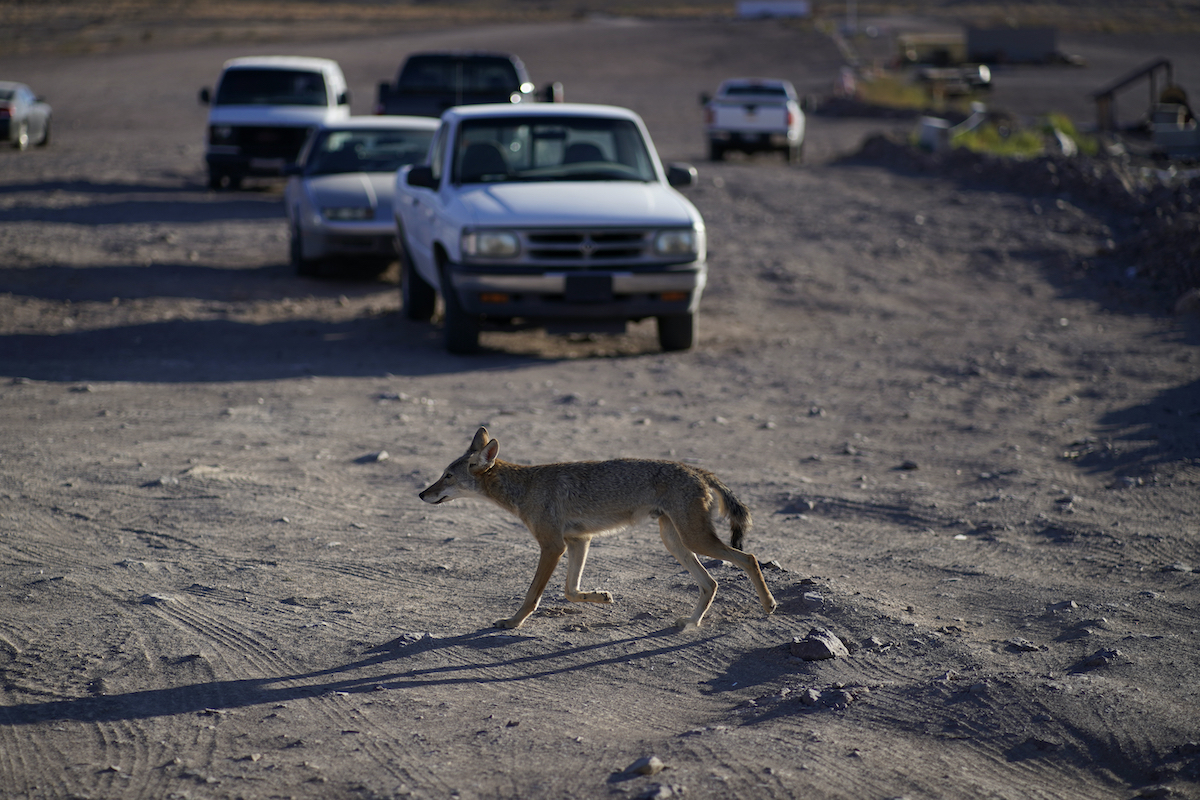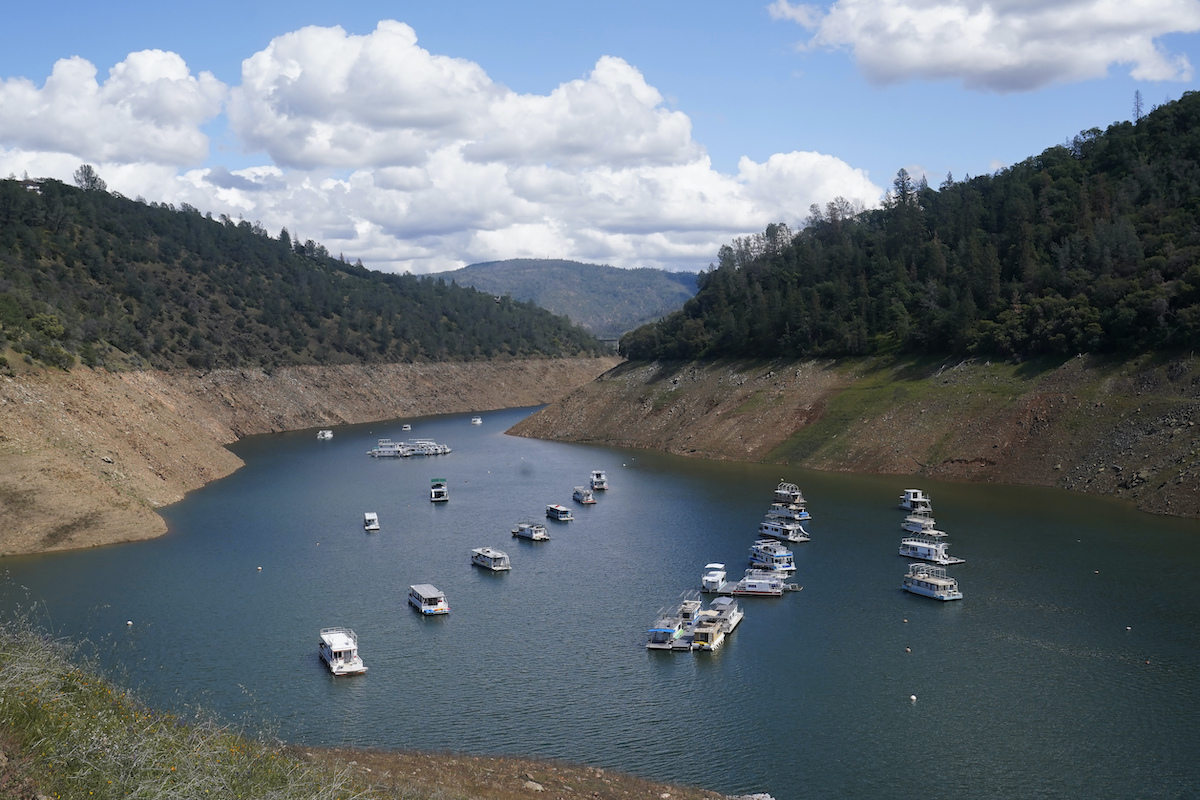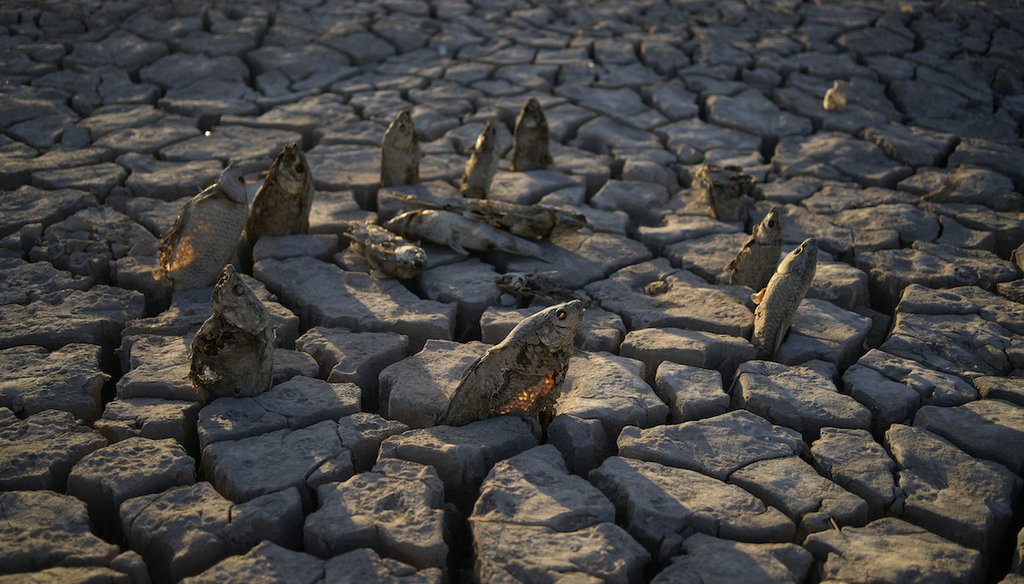

Our only agenda is to publish the truth so you can be an informed participant in democracy.
We need your help.


Dead and desiccated fish arranged by a visitor to the Lake Mead National Recreation Area stick out of cracked mud on June 28, 2022. The area, once under the waters of Lake Mead, dried up as water levels dropped. (AP)
More than 50% of the contiguous United States was experiencing drought as of July 12, according to National Integrated Drought Information System data.
The Facebook post links the claim that "drought is a lie" to unsubstantiated conspiracy theories.
Some places have set regulations to conserve water because it is scarce, but there’s no evidence these actions are tied to efforts to reduce the food supply and control Americans.
Following months of debunked claims that fires and explosions at farms and food processing plants were proof that planned food shortages are imminent, social media users have added a new ingredient to the plot: water.
One such post claims that the QAnon refrain "watch the water," points to efforts to create food shortages and control Americans.
"When Q told us to watch the water it had nothing to do with snake venom or foreign invasion," read a July 6 post. "Watch the water was concerning drought, and the control of the food supply based on climate change fraud. Why do you think so many food processing plants were being burned down? … Drought is a lie, so they can turn off the taps and limit farming to further control the food growth of this country and thus control the people."
The post was flagged as part of Facebook’s efforts to combat false news and misinformation on its News Feed. (Read more about our partnership with Facebook.)
"Q" refers to an anonymous internet persona who promoted a widespread, baseless conspiracy theory centered on the belief that a secret cabal of Satan-worshipping pedophiles, including many prominent Democrats and celebrities, is operating a global sex-trafficking ring that former President Donald Trump was recruited to take down.
PolitiFact has debunked a number of QAnon claims, and this post’s claim that "they" are lying about drought to control Americans is false, too.
Much of the U.S. is experiencing drought. The National Centers for Environmental Information describes drought as "the absence of water" that "slowly sneaks up and impacts many sectors of the economy, and operates on many different time scales."
Just over 50% of the lower 48 states were in drought as of July 12, according to the National Oceanic and Atmospheric Administration’s National Integrated Drought Information System. Including Hawaii and Alaska, 44.98% of the U.S. was in drought.

A coyote walks across dry land that was once under the water of Lake Mead near Hemenway Harbor at the Lake Mead National Recreation Area on, July 4, 2022, in Boulder City, Nev. (AP)
The weekly updated U.S. Drought Monitor map shows the location and intensity of drought across the U.S. using a five-category classification: abnormally dry (predrought conditions), moderate, severe, extreme and exceptional drought.
About 218 million acres of U.S. crops, largely corn and soybeans that rely on rain rather than irrigation, were experiencing drought, and 40 states were experiencing moderate drought or worse, the week of July 6 to July 12, according to national data.
The Drought Monitor map is created by scientists from the NOAA, the National Drought Mitigation Center at the University of Nebraska, Lincoln and the U.S. Department of Agriculture who evaluate regional drought conditions, consult with experts and publish the map.
"Each week, drought experts consider how recent precipitation totals across the country compare to their long-term averages," the National Integrated Drought Information System’s website said. "They check variables including temperatures, soil moisture, water levels in streams and lakes, snow cover and meltwater runoff. Experts also check whether areas are showing drought impacts such as water shortages and business interruptions."
There’s no evidence that these organizations are lying about droughts in the U.S, as the post suggests. But we found numerous news reports in which farmers and others reported drought-related setbacks and changes.
One California farmer told CNN he didn’t have enough water to plant crops on all his land, so he stopped growing asparagus and sweet corn. BBC reported that another farmer in California said he didn’t have enough water to plant his usual tomato crop. In Arizona, a farmer told CNBC he’d stopped growing cotton, which requires more water, to focus on corn, wheat and alfalfa.
In 2021, the severe drought in the West drained reservoirs, reducing hydropower plants’ output. Power production was down 25% at the Hoover Dam in Nevada, one of the largest hydropower generators in the U.S., The Associated Press reported. Compared with a 10-year average, California hydropower plants generated 48% less electricity in 2021 — and the outlook in 2022 is worse, per MIT Technology Review.

Houseboats sit in the drought lowered waters of Oroville Lake, near Oroville, Calif., on April 19, 2022. (AP)
Australia’s ABC News reported that the Great Salt Lake in Utah has lost nearly half its surface area from the historic average and now contains just one-fourth of the water it held at its high point in 1987. Since 2000, the flow of the Colorado River has declined almost 20%, the Los Angeles Times reported.
Researchers attribute 42% of the extended drought in the Southwest since 2000 and 19% of the severe 2021 drought in the Southwest to human-caused climate change, The Washington Post and CNBC reported.
Some places have set regulations to conserve water, but there’s no evidence these actions are tied to efforts to reduce food supplies and control Americans.
A Facebook post claimed that "drought is a lie" designed to limit farming, reduce the food supply and ultimately control Americans.
There is no evidence to support this claim, which the post links to unsubstantiated conspiracy theories. Data shows that more than 50% of the contiguous United States was in drought as of July 12.
We rate this claim Pants on Fire!
RELATED: This 95-item list doesn’t prove there are ongoing plans to create food shortages
RELATED: What is QAnon, the baseless conspiracy spilling into US politics?
PolitiFact, "Stew Peters film ‘Watch the Water’ ridiculously claims COVID-19 is snake venom. That’s Pants on Fire," April 19, 2022
PolitiFact, "A fact-checker’s guide to Ginni Thomas’ texts to Trump’s chief of staff," March 25, 2022
Union of Concerned Scientists, "The Equation: Causes and consequences of epic Western US drought," March 7, 2022
National Centers for Environmental Information, "Definition of drought," accessed July 15, 2022
Drought.gov, "U.S. Drought Monitor (USDM)," accessed July 15, 2022
Drought.gov, "National Current Conditions," archived July 15, 2022
Drought.gov, "New NOAA Report: Exceptional Southwest Drought Exacerbated by Human-Caused Warming," Sept. 28, 2021
U.S. Drought Monitor, "What is the USDM," accessed July 15, 2022
Gizmodo, "The U.S. drought situation is getting increasingly desperate," June 6, 2022
BBC, "Drought-stricken US warned of looming ‘dead pool,’" June 3, 2022
CNN, "California drought is pushing Latino farmers and workers to make difficult decisions," June 4, 2022
MIT Technology Review, "Droughts are cutting into California’s hydropower. Here’s what that means for clean energy," April 1, 2022
Associated Press, "Hydropower decline adds strain to power grids in drought," Oct. 10, 2021
The Washington Post, "The Colorado River is in crisis, and it’s getting worse every day," May 14, 2022
Arizona Republic, "How low can the Colorado River go? Drought forces states to face tough choices about water," March 21, 2022
Los Angeles Times, "As water crisis worsens on Colorado River, an urgent call for Western states to ‘act now,’" June 20, 2022
Arizona Republic, "Dry boat ramps, exposed rocks at Lake Powell reveal the cost of Colorado River drought," March 1, 2022
AgriLife Today, "Farmers look for late-season planting options," July 6, 2022
The Washington Post, "Southwest drought is the most extreme in 1,200 years, study finds," Feb. 15, 2022
CNBC, "Western drought fueled by climate change is the worst in 1,200 years, scientists say," Nov. 14, 2022
PBS News Hour, "Drought-stricken Nevada enacts ban on ‘non-functional’ grass," June 7, 2021
CBS Los Angeles, "California bans watering of ‘nonfunctional’ ornamental grass at commercial, industrial buildings," May 25, 2022
ABC News Australia, "Great Salt Lake in Utah hits record low levels amid two-decade drought, sparking warning of 'devastating' impact," July 16, 2022
U.S. Department of Commerce and Agriculture, "Weekly weather and crop bulletin," July 12, 2022
CNBC, "Empty canals, dead cotton fields: Arizona farmers are getting slammed by water cuts in the West," April 3, 2022
In a world of wild talk and fake news, help us stand up for the facts.
